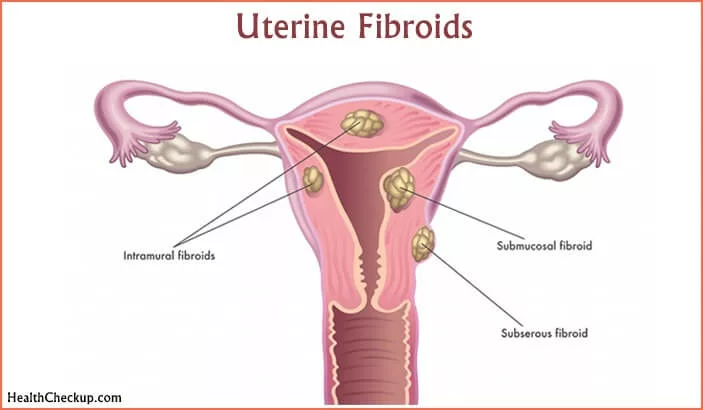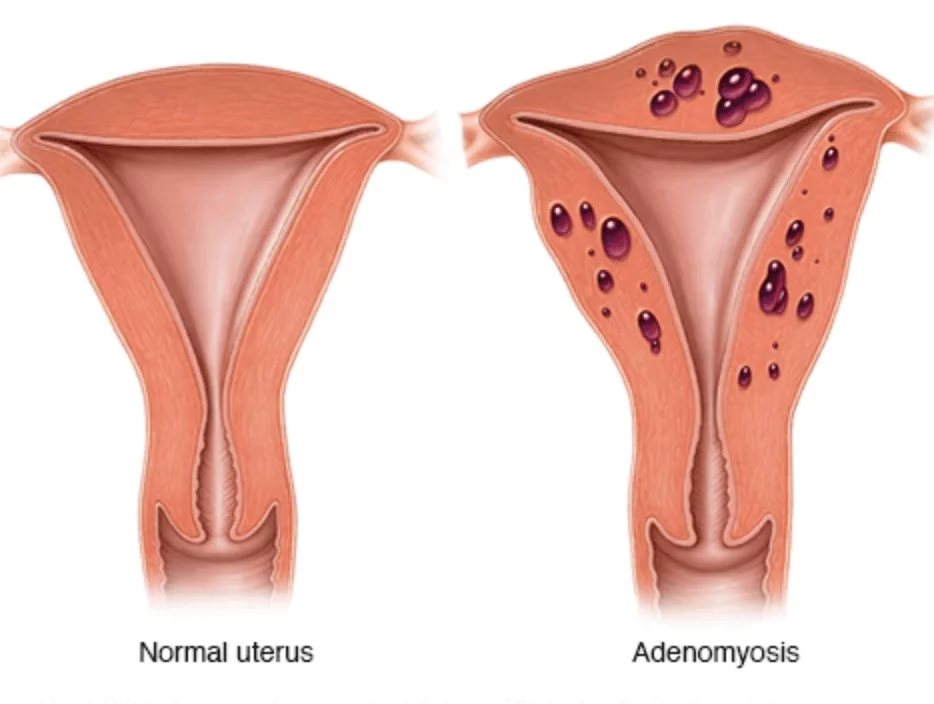If you suffer from painful, heavy periods that interfere with your everyday activities, an underlying menstrual condition could be to blame. Two of the most common causes of significant pain and excessive bleeding are fibroids and adenomyosis. Keep reading to learn more about these menstrual disorders and how they can affect your health:
Adenomyosis
Adenomyosis is a condition where the cells of the uterine lining (the endometrium) grow into the muscle wall of the uterus (the myometrium).
During each menstrual cycle, these displaced endometrial cells continue to perform its usual functions and thicken, break down, and bleed within the muscle wall.
The surrounding muscle swells and forms fibroid tissue in response to the irritation. This can result in an enlarged and tender uterus, heavy menstrual bleeding, and painful periods.

Symptoms of adenomyosis include:
- Painful, heavy and prolonged periods
- Menstrual cramps during the entire period of menstruation
- Blood clots during menstrual bleeding
- Enlarged or tender uterus
- Pain during sexual intercourse
- Chronic pelvic pain
- Feeling of fullness or pressure in the pelvic area
- Abdominal bloating/swelling
- Pressure on the bladder and rectum
- Pain or discomfort during urinating
- Leg or bowel pain during periods
- Difficulty in getting pregnant
Who Can Have Adenomyosis
Adenomyosis is most often diagnosed in middle-aged women, women who have children, and women who have had prior uterine procedures. It’s estimated that 70% to 80% of adenomyosis cases are reported in women in their 40s and 50s. The cause of adenomyosis is unknown, although there are several theories regarding possible causes.
Experts believe that uterine incisions, such as a C-section, could make it possible for endometrial cells to invade the muscle of the uterine walls by providing some form of an access point. Childbirth itself may provide the mechanism for invasive tissue growth if inflammation breaks the usual boundaries of the uterine lining.
Adenomyosis may not necessitate treatment, as every case is different. Some women are never symptomatic while others may suffer for years. Treatment for adenomyosis in premenopausal women includes hormonal therapy, endometrial ablation, uterine artery embolization, MRgFUS, and hysterectomy. Adenomyosis typically disappears after menopause, when estrogen levels decline.
What are Fibroids?
Fibroids are smooth, muscular tumors that grow in the wall of the uterus. They develop from normal uterus muscle cells that start growing abnormally into benign masses or tumors. They affect as many as 8 in 10 women by the age of 50, and depending on their size and location, they can be asymptomatic or cause heavy menstrual bleeding, pelvic pain, and bulk symptoms.

Symptoms of fibroids include:
- Painful, heavy and prolonged periods
- Enlarged or tender uterus
- Pain during sexual intercourse
- Unpredictable menstrual cycles
- Pain during sex and loss of libido
- Pelvic pressure, distended and bloated abdomen
- Pelvic pain, lower back pain, and pain in the back of the legs
- Anemia that can lead to a lack of energy and fatigue
- Weak bladder control, frequent urination because of bladder pressure
- Constipation or incontinence
- Infertility
Fibroids and Genetics
While it’s unknown exactly what causes fibroids, it’s believed that hormones and genetics play a role in their growth. Fibroids are not directly caused by hormones, but they do grow under the influence of hormones such as estrogen and progesterone, which is why hormonal therapy is also effective at treating fibroids.
Like adenomyosis, fibroids are most often diagnosed in middle-aged women. Evidence suggests that uterine fibroids have a disproportionate effect on African-American women, who are more likely to have fibroids than other racial groups. Women who have a family history of uterine fibroids are also more likely to develop fibroids. Interestingly, the risk of fibroids is higher in women who’ve never given birth while the risk of adenomyosis is lower in those who’ve never given birth.
Differences and Similarities
Both adenomyosis and fibroids share symptoms but are distinctly different diseases.
Adenomyosis is the physical thickening of the uterus that occurs when the tissue of the lining of the uterus grows into the myometrium – the uterus’ outer muscular walls. The cells, though displaced, continue performing their usual functions during menstruation, which leads to heavy, painful periods.
Fibroids are noncancerous tumors that grow from the muscle layers of the uterus. They are the product of smooth muscle cells that start growing abnormally. Depending on their location and size, they can create a wide range of health problems, and their symptoms include heavy, painful periods.
Fibroids can also cause other symptoms, such as abdominal bloating, urinary frequency, and constipation. These are known as bulk-related symptoms that result from the positioning of the fibroids relative to other organs in the body. For instance, if a fibroid is pressing on the bladder, it’s likely that a woman might feel like she needs to go to the bathroom frequently. Likewise, a fibroid pressing on the rectum can lead to constipation.
How to Get Diagnosed
Because adenomyosis and fibroids share almost the exact same symptom profile, it is near impossible to distinguish the two based on symptoms alone. In order to be able to say with confidence which condition you have, you need to get a professional diagnosis from an OB/GYN or a fibroid specialist. After assessing your symptoms, they will do a full physical workup, which may include:
- A pelvic exam that reveals an enlarged, tender uterus
- Ultrasound imaging of the uterus
- Magnetic resonance imaging (MRI) of the uterus
- Lab tests, such as an endometrial biopsy
With the help of a women’s health expert, you can pinpoint the root of your health issues and begin to formulate a plan for treatment.



